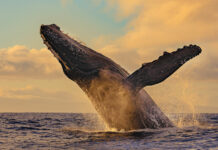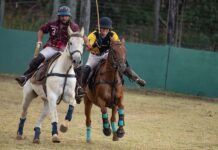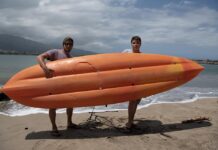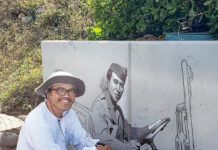Jamie Woodburn| Photography by Soul Fabric Films | Chris O’Kieffe
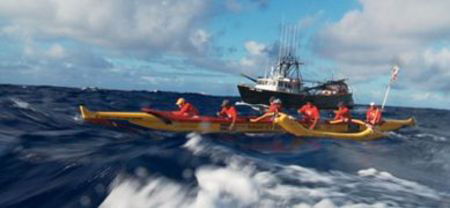 We were six paddlers in an outrigger canoe in the middle of the Pacific Ocean. Darkness engulfed us. Angry seas churned and spit in the strong, cold, quartering winds; swells careened our vessel up and down twelve-foot walls of water. Aware that the smallest mistake might end in the sea’s swallowing our tiny craft, we paddled on. We were soaked, cold, awestruck . . . and euphoric. This was the dream we had worked toward for more than six years.
We were six paddlers in an outrigger canoe in the middle of the Pacific Ocean. Darkness engulfed us. Angry seas churned and spit in the strong, cold, quartering winds; swells careened our vessel up and down twelve-foot walls of water. Aware that the smallest mistake might end in the sea’s swallowing our tiny craft, we paddled on. We were soaked, cold, awestruck . . . and euphoric. This was the dream we had worked toward for more than six years.We were paddling the final voyage of a journey begun with the vision of the late Kawika Kapahulehua, first kapena (captain) of the modern-day voyaging canoe Hokulea. Kawika’s lifelong dream had been to see all the islands in the 1,650-mile-long Hawaiian Archipelago connected by outrigger canoe. Though he did not live to see it, in 2002, under the leadership of his nephew, Kimokeo Kapahulehua, the Hawaiian Outrigger Canoe Voyaging Society was formed to undertake this journey as the ancestors themselves might have done—an achievement that had never been accomplished in recorded history.
If successful, it would open the way for the voyaging society to achieve its larger purpose of sharing the culture, beauty and history of the archipelago with a public whose knowledge about Hawai’i’s treasured northwestern islands is scant indeed.
During those six years, the society had completed voyages among all the main, inhabited islands, and beyond: from Kaua‘i to Nihoa, from Nihoa to Mokumanamana (Necker), and in 2006 from Mokumanamana 450 miles to Laysan—a whole time zone away. With each consecutive voyage, the miles, the planning, and the dollars necessary to accomplish the paddle grew exponentially.
Between the major islands—Hawai‘i, Maui, O‘ahu, Kaua‘i—any boat would do as our escort, so long as it could carry additional team members and follow our progress. For this, our final voyage, we needed a vessel seaworthy enough to travel over 3,000 miles from Kaua‘i to Kure Atoll and back, big enough to carry not only personnel and provisions, but the canoe itself, since we planned to motor to Laysan, and from there launch the canoe for the final leg to Kure. Once we reached the atoll, we would board the escort vessel to return to Kaua‘i.
From the outset, we had decided to paddle nonstop. Two teams of six paddlers would rotate in and out of the canoe each hour. On earlier voyages, we had traversed distances of perhaps 100 miles; this time, we’d paddle more than 430.
In addition to our twelve regulars, we recruited four alternate paddlers to relieve team members when sleep deprivation and plain physical and mental exhaustion required more than a one-hour break. Hopefully, this relief shift would give each team member a three- to four-hour respite for sleep one or twice during the estimated seventy-five-hour paddle. We had also acquired a film crew that would document this final voyage. Add to this the ship’s captain and crew, and our escort vessel would carry twenty-seven individuals in all.
Finding that vessel proved to be one of our biggest challenges. The Lady Alice, a ninety-foot commercial fishing boat, would become our oasis and home—once we had constructed sleeping quarters for sixteen additional “residents.” The vessel had to be outfitted with every piece of safety gear imaginable to meet U.S. Coast Guard regulations. Now add 20,000 gallons of fuel, food, kitchen gear, medical supplies, and everything else needed to support our team and crew at sea over fifteen days.
Planning and organizing the voyage took a daunting sixteen months. Raising the more than $175,000 we’d need for supplies and permits took us up to our last day on shore, but with the help of many friends and a generous community, we found ourselves on Kaua‘i, July 8, 2008, ready to launch.
We had been fortunate with our 2006 voyage to Laysan in being the first applicants granted access to the waters surrounding the newly formed Papahanaumokuakea Marine National Monument, now managed by the National Oceanic and Atmospheric Administration (NOAA). With Kure, our fortune evaporated. We battled with the regulatory agencies (NOAA, the U.S. Fish and Wildlife Service, and the state Department of Land and Natural Resources) to grant us permits into the monument area—permits we had secured the year before, but which were denied for this voyage.
That denial was a devastating blow, and nearly shipwrecked our dream. But we were determined to circumnavigate the monument and fulfill Kawika’s vision. At last, we received approval for two transits of the Lady Alice inside the monument.
One transect took place early in the voyage: We were allowed to enter with our canoe on board, and without stopping or conducting any operations within Papahanaumokuakea, to continue on a course that would take us past Nihoa and out of the monument on a course paralleling its northern boundary. Our second transect would allow us to reenter Papahanaumokuakea after completing our paddle, and take us to the southern boundary of the monument for our return to Kaua‘i.
The first island in the newly created marine monument, Nihoa is a sight many of us had become familiar with. The Islands of Hawai‘i increase in age as you move in a northwesterly direction. The Big Island is approximately half a million years old; Kure Atoll, the granddad of the archipelago, more than 70 million. Nihoa, estimated at 7.2 million years old, stands like a sentinel, the great gatekeeper of the Northwestern Hawaiian Islands. Majestic cliffs on its eastern and western coasts create a commanding presence in an otherwise deserted and vast ocean.
As we approached, someone on board blew the conch shell, and Kimokeo began to chant. With full hearts and a few tears, we joined him in giving thanks and paying respect to na mokupuni na kupuna, the islands of the ancestors. Prior to the launch of our canoe, Kimokeo would lead us in another profound ceremony, acknowledging Hawaiian protocol and requesting permission to enter the waters of the elder islands.
Our first day of paddling offered relatively mild weather and a consistent swell that gave all the paddlers the opportunity to relax a bit, find their rhythm, and get accustomed to paddling in the deep blue waters of the Northwestern Hawaiian Islands. For some of us, it was a return that rejuvenated our spirit and reminded us what a privilege it was to be voyaging in these waters. For the newest paddlers, every minute was an adventure reflected in their expressions of awe, excitement, and a touch of trepidation.
It wasn’t long, however, before our tranquil days and nights transitioned into washtub seas, stinging winds and huge swells. Words fall short in describing the feeling you have after being summoned by your teammates at 2 a.m. for your next rotation, when you’ve had just twenty minutes’ sleep.
Zombie-like, you join the others on deck. The skies are pitch black and the first sensory impulses you receive are blasts of cold air and horizontal rain that drives against your skin like glass shards in the twenty-five-knot winds. You have only minutes, perhaps seconds, to prepare mentally and physically for the transition that will take you from the shelter of the Lady Alice into the tiny Zodiac bobbing like a cork at the escort vessel’s side. You jump from the stern into the Zodiac and within moments are launched into the vast, all-consuming darkness. Like insects clinging to a twig in a storm drain, you and your teammates wait for the approach of the canoe and the delicate transfer of humans from Zodiac to canoe, canoe to Zodiac. It is a harrowing scenario, one that plays out hourly throughout our seventy-six-hour sojourn.
The paddlers for this voyage were among our best, ranging in age from sixteen to sixty. They included three women and five men from Maui, a tight-knit “super-jock” crew of six from Northern California, and two powerhouse paddlers from Kaua‘i. Many had been on other legs of these voyages through the Northwestern Hawaiian Islands. Three, Kimokeo, Chris Luedi, and I, had been on every trip from the beginning.
Each of us, veteran and newcomer alike, had made sacrifices and huge commitments of time and money to be part of this voyage. For some that meant putting careers and family life on hold. For others it meant overcoming physical hurdles that were significant and even life threatening. Kendall Struxness made the ultimate commitment, joining us despite a personal fight with cancer. Over the fifteen days of the voyage, as we strove to achieve our audacious goal, we became an ‘ohana (family).
While in transit aboard the Lady Alice, we had spent our days trying to stay dry and out of the sun. “Fish on!” was a frequent cry; as reels screamed, Alec Ibarra, Peter Niess and Theron Forestor would race to the rods to bring in whatever was yanking the line off the reels at unbelievable speeds. Fresh fish was on the menu of nearly every meal. Peter and his nephew, Alec (at sixteen our youngest paddler and deck hand), had assumed the roles of primary fishermen. Pepe Trask, one of the founders of the Hawaiian Outrigger Canoe Voyaging Society, willingly took on the task of cleaning the ono, marlin, mahimahi and aku they hauled in—always with a smile.
Matt Muirhead and his team from Santa Cruz spent their time working out to stay on top of their game for the big paddle. George Lingle seemed forever engaged in whatever he thought necessary—like installing a crude tollgate at the stern of the vessel to alert others when our aft-mounted toilet was in use. Chris Luedi spent his first two or three days on board catching up on sleep and repeating, “I came to paddle.” It was great fun to watch Chris let go of his proper Swiss demeanor and join in the jovial banter.
With each sunrise and sunset, I observed and occasionally joined Kimokeo and George Rixey in their chants, as they gave thanks for the day and acknowledged the blessings of the ‘aumakua (family gods) and kupuna who watched over us. Kimokeo, our kapena and constant cultural advisor, spent his days teaching some of the chants and rituals that would be presented during the voyage. The women paddlers, Anita, Colleen and Ryn, were invariably helpful, and ready with words of encouragement. Kendall put his challenge with cancer aside. He and I would often bump into each other—literally—as we stumbled around the deck and kitchen areas in the predawn hours, looking for something to eat, or in search of one of those elusive warm spots on the boat that you could lean against for relief from back pain.
For me, two things separated this voyage from the rest. The first was darkness. Our previous voyages had been planned around the full moon. This voyage afforded no such luxury. Although the sky was blanketed in billions of fiery stars, their light did little to illuminate the inky sea or the thickly veiled night. It was dark, way dark, so dark you had a hard time seeing the paddler in front of you.
Rhythm became intuitive, something felt rather than seen. We heard rather than saw the crashing mountains of water that engulfed the canoe as they passed from stern to prow. Each of us was keenly aware that at any time we could easily huli (flip over). A paddler separated from the canoe in this dark sea would likely never be found. For the first time, we rigged an ama line—a cord that stretched between the ‘iakos (booms) of the canoe. When the wind and swells lifted the ama (outrigger) out of the water, we’d lean our weight into the line to force the ama down again.
The rougher the seas grew, the closer we stayed to our escort vessel. The stress was tangible, relieved only when we had made our transition from the Zodiac to the safety of the Lady Alice.
Because we had had to circumnavigate the monument, island waypoints that had marked our progress during previous voyages were absent, replaced by points on a chart and GPS readings. We monitored our progress closely, making small course adjustments that we hoped would spare us from head-on winds and currents that at times slowed our progress from six to three knots. We paddled on through elements, through fear, holding to our commitment to finish.
Our final transect came at dawn the day after we completed our paddle, when we passed our destination—Kure Atoll. Deeply moved, we gave thanks and acknowledged the profound experience we had just completed. Lifelong bonds had been formed among team members, some of whom had been strangers just eight days prior.
The one emotion that wove its way through all the sessions and all the paddlers was a deep sense of appreciation. Appreciation for the host culture and for those early travelers who had preceded us millennia ago, enduring far more difficult conditions on their own voyages of discovery. Appreciation for the men and women who had come together to accomplish something monumental, something that had not been achieved before in modern times: to paddle the length of the Hawaiian Archipelago, 1,650 miles. It was the canoe that had done this—the canoe that had brought these paddlers together to give life to the vision conceived by Kawika Kaphulehua, and continued by Kimokeo Kapahulehua.
The voyage touched each paddler profoundly, and in different ways. It strengthened my appreciation of life and demonstrated once again how fortunate I am to have been part of this voyage. Paddling hundreds of miles from the nearest point of land, a mere speck in the vast, open ocean, reminded me how special our time on the planet is and how important it is to seize each moment and to live life to its fullest. As we begin to discuss future voyages, whether in Tonga, Tahiti or Palmyra, I know there is a group of tight-knit paddlers, our ‘ohana, who now call themselves Voyagers and who, like me, will sign on for another experience of a lifetime.
For information about the film documenting this voyage, contact: Soul Fabric Films, www.soulfabricfilms.com 1take@soulfabric.net.
For information on Papahanaumokuakea Marine National Monument, 808-397-2660 | www.hawaiireef.noaa.gov

